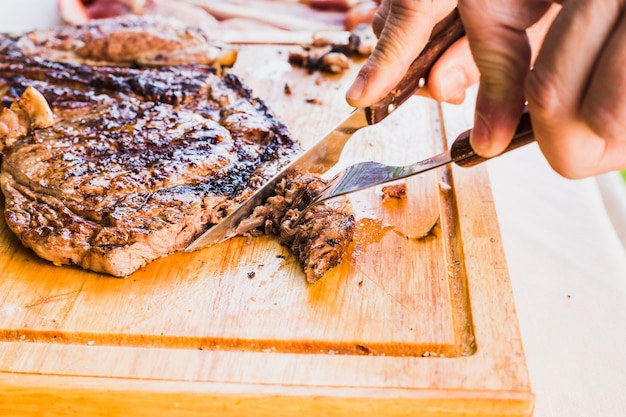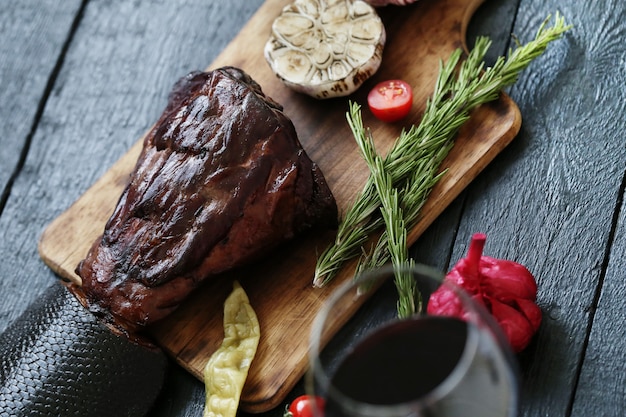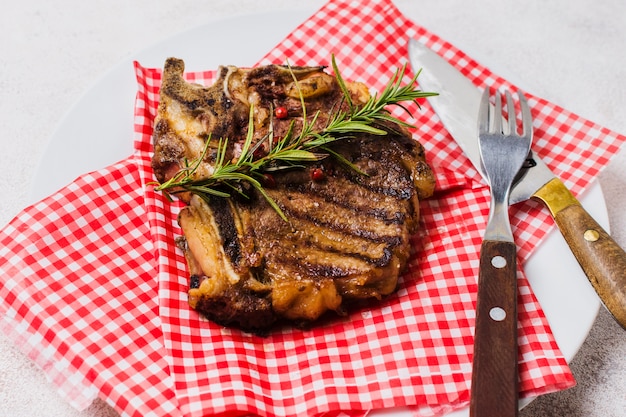Ah, the rib roast. It's a crown jewel in the culinary world, a symbol of celebration and feasts, a showstopper that melts in your mouth with every bite. But achieving that perfect, tender, juicy result can seem daunting, especially for novice cooks. Don't worry, I'm here to guide you through the process, sharing my years of experience and culinary wisdom. This guide is more than just a recipe; it's a roadmap to unforgettable rib roast perfection.
(Part 1) choosing the right cut: The Foundation of Flavor
The first step, like in any good journey, is choosing the right path. In this case, that path starts with selecting the right cut of meat. Believe me, it's crucial to start with a cut that's brimming with flavour and the potential for tenderness.
prime rib: The Classic Choice
If you're looking for the gold standard, the most sought-after cut, then prime rib is your king. It's a classic for a reason, you know? You'll often find it labelled as "standing rib roast" or "rib roast with bone," and it's worth every penny. That bone, my friends, adds a depth of flavour you wouldn't believe. And for me, a three-bone roast is perfect for a cozy family dinner, while a seven-bone behemoth can feed a whole army. But remember, prime rib is a special occasion kind of cut, so don't be afraid to splurge!
Standing Rib Roast: A Worthy Challenger
A close contender to the prime rib is the standing rib roast, also known as a "rib roast with bone." This is like prime rib's slightly less fancy cousin, but still very impressive. It's generally more affordable than its pricier counterpart, and it still delivers that magnificent bone-in flavour.
beef ribs: The budget-friendly Option
Now, let's talk about beef ribs. They're a little more casual, a bit more down-to-earth, but don't be fooled by their humble nature. They can be incredibly flavorful and tender, especially when cooked low and slow. Think of them as the "comfort food" of the rib roast family. They're perfect for a casual gathering or a weeknight treat.
(Part 2) Preparing the Roast: Laying the Groundwork for Success

You've got your perfect cut, now it's time to prepare it for its starring role. This part is all about getting the roast ready to soak up all those delicious flavors.
Pat Dry and Season: A Foundation of Flavor
First, pat that roast dry with paper towels. This is crucial for getting the seasoning to stick, creating a beautiful crust, and preventing steam from forming while cooking. Now, the fun part: seasoning! You can go simple with salt and pepper, or get creative with a blend of herbs and spices. My personal favorite? Salt, pepper, garlic powder, onion powder, and paprika. It's a classic combination that works wonders.
Rub It In: A Massage for Flavor
Take your seasoning blend and rub it all over the roast, really getting into those crevices. It's a good time to get your hands dirty, literally! This helps the seasoning penetrate the meat, creating a delicious flavor throughout.
Let it Rest: The Magic of Time
Now, this is where patience comes in. Let the roast rest in the fridge, uncovered, for at least 24 hours. This allows the seasoning to work its magic, infusing the meat with those deep, complex flavors. Trust me, it's worth the wait!
(Part 3) Cooking the Roast: Bringing it to Life

The moment has arrived! The roast is prepped, the stage is set. Now, it's time to bring your culinary masterpiece to life. There are two main ways to achieve rib roast perfection: roasting in the oven and slow cooking.
Roasting in the Oven: A Classic Technique
This is my go-to method, tried and true, it delivers consistently delicious results. Let's break it down:
Preheating the Oven: The First Step to Success
Preheat your oven to 450°F (232°C). That high heat is going to sear the surface of the roast, locking in all those juicy flavors.
Searing the Roast: A Crisp Crust and Flavor Lock
Place the roast in a roasting pan and sear it for 15-20 minutes on each side, until you get a beautiful, crispy crust. This step is all about creating that initial flavor explosion, that first impression of deliciousness.
Lowering the Temperature: Gentle Cooking for Tenderness
After that initial sear, reduce the oven temperature to 325°F (163°C). This gentle heat will cook the roast through to perfection, resulting in tender, juicy meat.
Slow Cooking: The Hands-Off Approach
If you're looking for a more relaxed approach, slow cooking is your best friend. It's all about those low and slow temperatures, resulting in incredibly tender, melt-in-your-mouth meat. Here's how to do it:
Seasoning and Browning: Setting the Stage
Season the roast just like you would for oven roasting, but instead of searing it in the oven, brown it in a large pot or dutch oven on the stovetop. This creates that delicious crust and infuses the meat with flavor.
Slow cooking time: Patience is Key
Transfer the browned roast to your slow cooker and cook it on low for 6-8 hours, or on high for 3-4 hours. Remember, cooking time will vary depending on the size of your roast, so keep a close eye on it.
(Part 4) Determining Doneness: The Art of Timing

Alright, this is where it gets interesting. You've got to know when your rib roast is cooked to perfection, that sweet spot between juicy and tender. It's a delicate balance, and it's all about timing.
meat thermometer: Your Culinary Compass
The most reliable way to check for doneness is with a meat thermometer. It's like a culinary compass, guiding you towards perfection. Here's a handy chart to guide you:
| Doneness | internal temperature (°F) | Internal Temperature (°C) |
|---|---|---|
| Rare | 125-130 | 52-54 |
| Medium-Rare | 130-135 | 54-57 |
| Medium | 140-145 | 60-63 |
| Medium-Well | 150-155 | 65-68 |
| Well Done | 160 | 71 |
Resting the Roast: The Final Touch
Once your roast has reached the desired temperature, remove it from the oven or slow cooker and let it rest for at least 15-20 minutes before carving. It's like giving it a little "nap" to redistribute those juices. This results in a more tender, flavorful roast, and trust me, it's worth the extra wait.
(Part 5) Carving and Serving: Unveiling the Masterpiece
The anticipation is building, the aroma is tantalising, and finally, it's time to unveil your masterpiece.
Carving the Roast: A Skillful Touch
Use a sharp carving knife to slice the roast into thin, even slices. If you're dealing with a standing rib roast, you'll need to remove the bones first. Carefully cut around the bones and lift them out. This is where a bit of skill comes in, but don't worry, practice makes perfect.
Serving Suggestions: A Symphony of Flavors
Now, it's time to create your symphony of flavors! Serve your rib roast with your favorite side dishes, such as creamy mashed potatoes, roasted root vegetables with a sprinkle of herbs, or a velvety risotto. For an extra touch of decadence, add a rich gravy or a flavorful sauce. Remember, the possibilities are endless!
(Part 6) Leftover Magic: Turning Leftovers into New Delights
Don't let those precious leftovers go to waste! They're an opportunity to create new culinary delights.
Rib Roast Sandwiches: A Comforting Treat
Slice the leftover roast thinly and pile it high on toasted bread with your favorite toppings, like creamy cheese, sharp onions, and tangy pickles. It's a comforting, satisfying treat that's perfect for lunch or a quick dinner.
Beef Hash: A Hearty and Flavorful Dish
Chop up the leftover roast and combine it with diced potatoes, onions, and other vegetables for a hearty and flavorful beef hash. It's a satisfying, soul-warming dish that's perfect for a cold day.
Beef Soup: A Rich and Comforting Meal
Use the leftover roast to create a rich and comforting beef soup. Add a medley of vegetables, aromatic herbs, and spices for a satisfying and flavorful meal. It's a perfect way to use up those leftovers and warm you from the inside out.
(Part 7) Tips and Tricks: Adding Finesse to Your Roast
Here are a few extra tips and tricks to elevate your rib roast to new heights of deliciousness:
Use a Roasting Rack: Ensuring Even Cooking
A roasting rack is your secret weapon for ensuring even cooking. It elevates the roast above the bottom of the pan, allowing for better airflow and a crispy, golden crust.
Basting the Roast: Adding Moisture and Flavor
For extra moisture and flavor, baste the roast with pan juices or a simple butter-wine mixture during the cooking process. This keeps the meat moist and tender, and adds a layer of richness to the finished product.
Resting Time: The Secret to Tenderness
Remember, always rest the roast for at least 15-20 minutes before carving. This allows the juices to redistribute throughout the meat, resulting in a more tender and flavorful roast.
(Part 8) Common Mistakes and How to Avoid Them: Lessons from Experience
Even the most experienced cooks can make mistakes, but learning from them is part of the culinary journey. Here are some common rib roast pitfalls and how to avoid them:
Overcooking the Roast: The Enemy of Tenderness
Overcooking is the biggest enemy of a tender, juicy rib roast. It can result in dry, tough meat, ruining all your hard work. Use a meat thermometer to ensure it reaches your desired level of doneness and no more.
Not Resting the Roast: The Key to Juiciness
Resting is essential for a juicy roast. Skipping this step will result in a less tender and flavorful roast. Give it that extra time to rest and redistribute its juices.
Not Seasoning Enough: The Foundation of Flavor
Don't be shy with the seasoning! Use a generous amount to enhance the natural flavors of the roast. Remember, the seasoning is the foundation of your culinary masterpiece.
(Part 9) FAQs: Answers to Your Burning Questions
Here are some common questions about cooking a rib roast:
1. What is the best temperature to cook a rib roast?
The best temperature for cooking a rib roast is 325°F (163°C). This gentle heat allows for even cooking and prevents the roast from drying out.
2. How long should I cook a rib roast?
The cooking time for a rib roast will vary depending on its size and desired level of doneness. A general rule of thumb is to allow 15-20 minutes per pound for medium-rare. However, it's always best to use a meat thermometer to ensure it's cooked to perfection.
3. Can I cook a rib roast in a slow cooker?
Absolutely! Slow cooking is a fantastic option for a rib roast. Cook it on low for 6-8 hours, or on high for 3-4 hours. The slow and gentle cooking process yields incredibly tender and flavorful results.
4. What are some good side dishes to serve with rib roast?
The possibilities are endless! Some classic side dishes for rib roast include creamy mashed potatoes, roasted root vegetables, and a velvety risotto. But you can also get creative with your choices, adding seasonal vegetables, hearty salads, or even a flavorful pasta dish.
5. What can I do with leftover rib roast?
Leftover rib roast is a treasure trove of culinary possibilities! You can use it to make delicious sandwiches, a hearty beef hash, or a comforting beef soup. It's also fantastic in tacos, burritos, or even as a filling for stuffed potatoes.
So, there you have it, folks! Your ultimate guide to cooking a perfect rib roast. With a little patience, practice, and a touch of culinary magic, you can create a masterpiece that will impress your guests and leave them craving more. Go ahead, grab your favorite cut of meat, and get ready to unleash your inner chef!
Everyone is watching

Prime Rib Roast Cooking Time Chart: Per Pound Guide
Cooking TipsPrime rib roast. Just the name conjures images of lavish dinners, crackling fires, and hearty laughter. It’s ...

How Long to Bake Potatoes in the Oven (Perfect Every Time)
Cooking TipsBaked potatoes are a staple in my kitchen. They're incredibly versatile, delicious, and surprisingly easy to m...

Perfect Rice Every Time: The Ultimate Guide to Cooking Rice
Cooking TipsAs a self-proclaimed foodie, I've always been a bit obsessed with rice. It's the foundation of countless cuisi...

The Ultimate Guide to Cooking Asparagus: Tips, Techniques, and Recipes
Cooking TipsAsparagus. The mere mention of this spring delicacy conjures up images of vibrant green spears, crisp and burs...

Ultimate Guide to Cooking the Perfect Thanksgiving Turkey
Cooking TipsThanksgiving. Just the word conjures up images of overflowing tables laden with delicious food, the scent of r...
